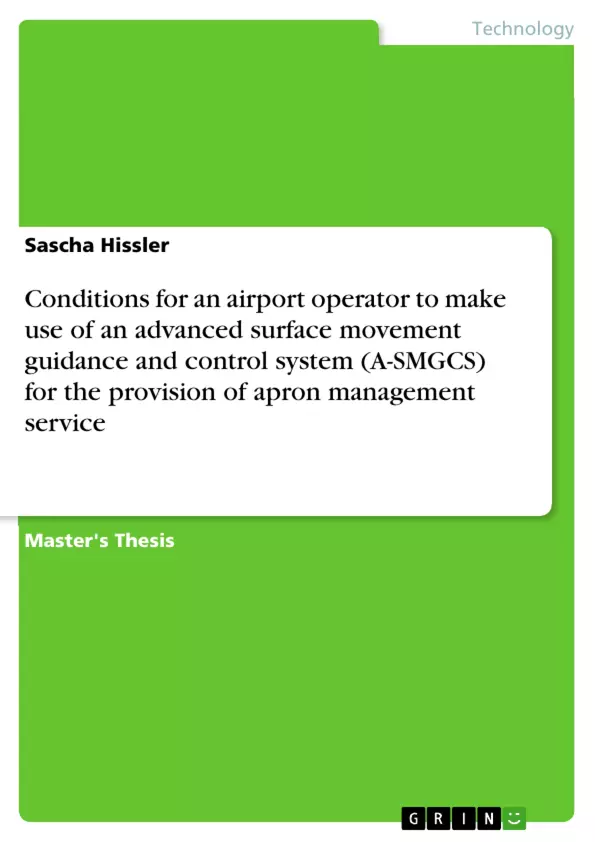With the amendment of the European Regulation (EC) No 216/2008 by the new Regulation (EC) No 1108/2009 (into force since 14 December 2009), the area of competency of the European Aviation Safety Agency (EASA) is progressively extended towards a “total system approach” including ATM, ANS as well as airport safety and interoperability. This new regulation allows airport operators to continue with providing apron management service – but they have to “declare their capability“ for offering this service within the certification process of the aerodrome.
An advanced surface movement guidance and control system is one important tool for providing this service at large and complex airports. With the implementation of an advanced surface movement guidance and control system (A-SMGCS), the airport contributes to the precise surface guidance of aircraft to and from a runway while maintaining safe distance to each other as well as to obstacles and vehicles. The system is aimed to assist the ground controllers in managing the traffic situation on the movement area in all weather conditions. Due to advanced surveillance technology, the ground movement controllers are able to continue operations with an A-SMGCS even in low visibility conditions (e.g. due to fog) and maintaining nearly the same capacity as with no visibility restrictions.
The focus of this master thesis is not on the operational and technical details of the system, which are profoundly analyzed and elaborated on by R&D projects, e.g. by the German Aerospace Center (DLR), European research projects and the industry. However, the second chapter will provide those details required to fully understand the legal and administrative aspects of an A-SMGCS.
If ANSP are using a system like A- SMGCS under safety aspects, they have to undergo a licensing process according to SES-regulations and are licenced by the national supervisory authority. The airport itself is licenced by the appropriate approving authority of the federal state. For Germany’s biggest airport, Frankfurt International Airport, it’s the ministry of transport of Hesse, the HMWVL. This ministry licences the airport as such as well as the safe provision of apron management service including the use of procedures and technical systems like A-SMGCS.
The conditions for this approval are subject of the Master's Thesis.
Inhaltsverzeichnis (Table of Contents)
- Introduction
- Statement of the problem
- Approach
- Elaboration on A-SMGCS
- Development towards A-SMGCS
- A-SMGCS Benefits
- A-SMGCS functional criteria
- Surveillance
- Control
- Routing/Planning
- Guidance
- The Four Levels of Implementation
- A-SMGCS Level 1 & 2
- A-SMGCS Level 3 & 4
- Further documents
- Relevance for the ANSP
- Legal Basis: ICAO
- Legal Basis: European Union
- EC No 549/2004: the framework Regulation
- EC No 550/2004: the service provision Regulation
- EC No 551/2004: the airspace Regulation
- EC No 552/2004: the interoperability Regulation
- EC No 1070/2009: amendments to SES I Legislative Package
- SES regulation and requirements for licensing
- National Supervisory Authority in Germany
- Requirements for certification
- Relevance for the airport operator
- Legal Basis ICAO: Apron Management Services
- Legal Basis in Europe: SES regulations
- Remit of EASA
- EC No 216/2008: common rules in the field of civil aviation
- EC No 1108/2009: Aerodromes, ATM, ANS, ATC
- Regulatory structure in Germany
- Political Hierarchy: The Federalism in Germany
- German Aviation Law: LuftVG
- German Aviation Regulation: LuftVZO
- Chart: Political hierarchy of aviation law in Germany
- New challenges for the approval authority
- The way to a “Declaration of Capability”
- Experts position
- Questionnaire
- Responses
- Recommendation for a “Declaration of Capability”
- Personal Opinion
- Particular situation at Frankfurt Airport
- Conclusion
- Fields for further study
Zielsetzung und Themenschwerpunkte (Objectives and Key Themes)
This Master’s thesis examines the conditions required for an airport operator to utilize an advanced surface movement guidance and control system (A-SMGCS) for the provision of apron management services. It explores the regulatory framework governing the use of A-SMGCS, focusing on both national and international legislation. The thesis aims to analyze the implications of using A-SMGCS for both air navigation service providers (ANSPs) and airport operators, particularly within the context of the European Union’s regulations.
- The implementation and use of A-SMGCS in apron management
- The legal framework for A-SMGCS use in the EU and Germany
- The role of the ANSP and airport operator in the A-SMGCS implementation process
- The implications of the “Declaration of Capability” for airport operators
- Challenges and opportunities presented by A-SMGCS technology in apron management
Zusammenfassung der Kapitel (Chapter Summaries)
The thesis begins with an introduction that outlines the research problem, the objective of the study, and the methodology employed. Chapter 2 delves into the concept of A-SMGCS, discussing its development, benefits, functional criteria, and different levels of implementation. Chapter 3 examines the relevance of A-SMGCS for the ANSP, analyzing the legal basis, regulatory requirements, and licensing procedures. Chapter 4 shifts focus to the airport operator, exploring the legal framework for apron management services, the remit of the European Aviation Safety Agency (EASA), and the regulatory structure in Germany. Chapter 5 explores the new challenges facing the approval authority in the context of A-SMGCS implementation, examining the process of obtaining a “Declaration of Capability”. Chapter 6 presents recommendations for achieving this declaration, considering the specific situation at Frankfurt Airport.
Schlüsselwörter (Keywords)
The key terms and concepts explored in this thesis include: A-SMGCS, apron management, air navigation service providers (ANSPs), airport operators, European Aviation Safety Agency (EASA), “Declaration of Capability”, regulatory framework, legal basis, licensing, certification, apron safety, and surface movement control.
- Arbeit zitieren
- Diplom-Staatswissenschaftler (Univ.), Master of Aviation Management Sascha Hissler (Autor:in), 2010, Conditions for an airport operator to make use of an advanced surface movement guidance and control system (A-SMGCS) for the provision of apron management service, München, GRIN Verlag, https://www.grin.com/document/168238



